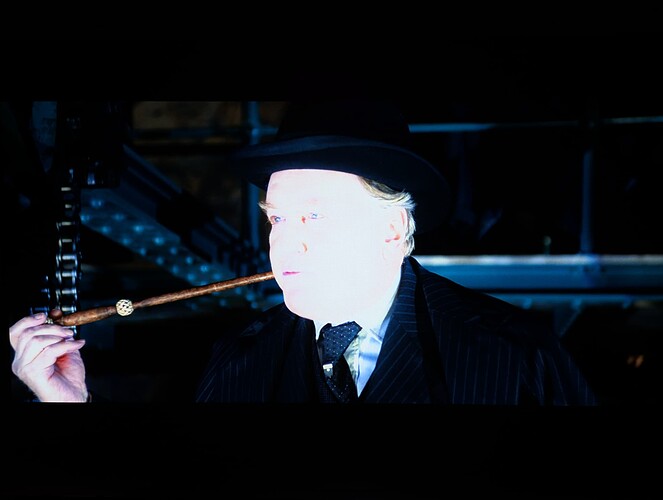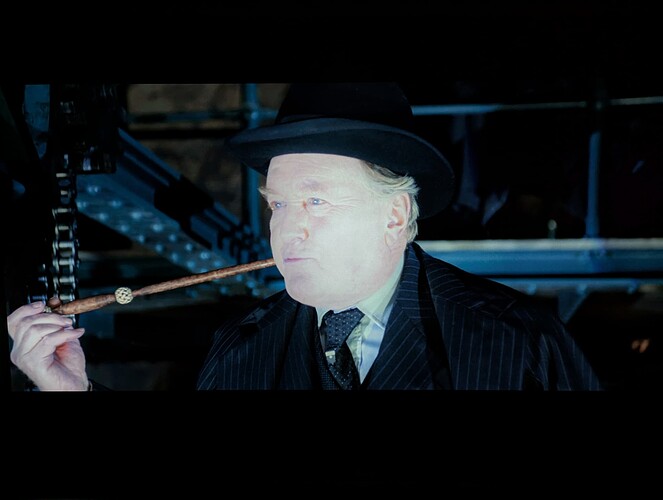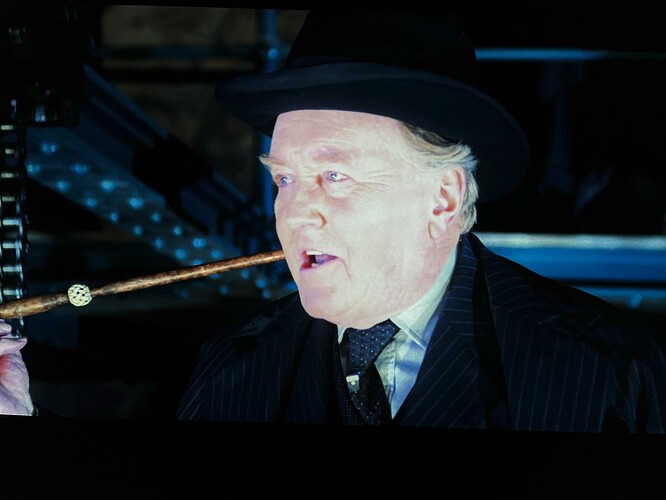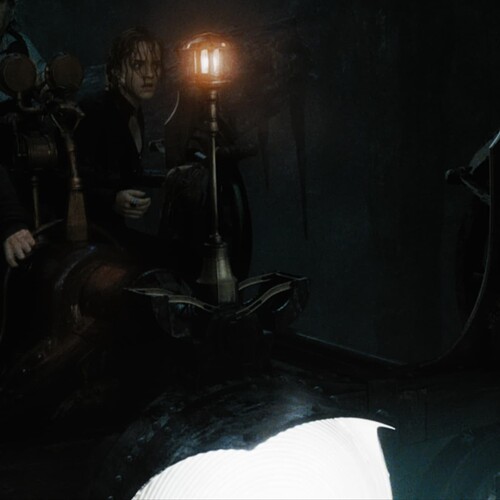The GoF sequence is over-cooked when played as HDR10. The DV version is essentially the same as HDR10 on the Vero. Apologies for sloppy use of terminology, I probably understand about 1% of this stuff.
Apologies not required. So as far as your Panny is concerned, DV is taking HDR10 and making it less bright, because of the DV metadata you have added? Ugoos is in TV-led mode, and Vero is in Auto, right?
Sorry - too many variables in this business.
the addition of DV data from Dolby’s CM Analyze tool (the 3-1 workflow in DoviScripts) is providing shot by shot data based on the automated analysis, and via the Ugoos and Infuse it transforms the playback of GoF. All devices in TV-led mode, Vero in Auto. What’s nice about the GoF example is that DV takes away the over-exposed look of the highlights and renders Hardy’s face much more naturally, so it’s easy to see it not working on the Vero.
The Harry Potter HDR10 releases could really do with DV, as they have many shots with ultra-extreme brightness.
This is from the HDR10 original.
I like how the details suddenly become visible when the dimming of the Vero kicks in after a couple of minutes when keeping the video paused ![]()
DV conversion via DoviScripts of HDR10 original, played on the Ugoos. My iPhone has slightly underexposed, display version is a touch brighter, but nowhere near the impossible-to-watch HDR10 version. This is what I’m looking to see from the Vero.
Do you have a link to a guide on how to use these scripts?
Oh my, so many things to install.
download page with instructions:
Main discussion place and announcements of latest news. Also gets discussed on the DV megathread on the makemkv forum.
The learning curve is a bit steep and close attention is required to the installation instructions in order for all the workflows to be possible (Windows only). There are all sorts of things you can do in terms of generating or analyzing DV data, and there are some utility workflows that I find handy. Some steps will be time-consuming however depending on your hardware.
I’ve now run all my HDR10-only titles through the Dolby CM Analyze workflow (you get P8 CM v4 with the HDR10 base untouched). Sure, for titles with fairly moderate peak nits grades it doesn’t make much difference, but for titles with ultra-bright peaks the benefit is very obvious, not just for highlight detail, but for colour balance overall. E.g. previously, when watching Inception in HDR10, I always had an impression that there was a slight wash of glare over many shots - with DV, that’s gone.
My workflow for a non-DV disc is to generate the HDR plot which also generates a placeholder rpu (workflow 6-2), and having reviewed the plot move on to workflow 3-1 that runs the full analysis - happy to move that to a PM discussion as there are some undocumented things to look out for which can save time when stepping between workflows.
Thanks, but I really don’t have the required knowledge about all this. I am not talking about being able to run those scripts but rather what all this terminology means. I know that there are different profiles which are used in different scenarios (streaming, UHDBD etc.) and that there is FEL and MEL but I don’t know from a technical perspective what the differences are and what’s best. So I guess I’ll stick with what I have until I’m motivated enough to go into that rabbit hole. But thanks anyways.
perfectly fair position. There are times when I think that trying to understand everything associated with DV makes quantum mechanics seem straightforward!
I just want to make sure I am following this because I don’t own the Harry Potter UHDs, but according to blu-ray.com they do not have DV, just HDR10.
So the only way you get DV is to inject the WEB DV into the UHD remux via dv-scripts.
And now, after doing that untraditional method, we have a file we can see a difference between the DV handling of Ugoos and Vero V.
Well, the Ugoos will handle FEL and we know the V will not, at this point in time, so I have to imagine that this difference is in the FEL.
So the V gives you BL+RPU while the Ugoos gives you BL+FEL+RPU.
Unless the V is going to bake in FEL on the fly or something crazy like that I imagine this difference is not going to be “fixed”.
I put the word fixed in quotes because it is my understanding that even a retail UHD disc player and TV that both support DV would only show HDR10 on the retail discs anyway and that would give you your blown out issues too.
This is one of the things that’s annoying about UHD discs, this should have been fine in HDR10, there’s no reason for them mastering it with such blown out highlights, but alas they did.
It’s nice to know that we can use open source tools to “fix” these things, and hopefully the OSMC team can find a solution, but we should have never had to do this kind of stuff in the first place.
I’m all for the V doing something about FEL but I wouldn’t hold my breath.
If they CAN, then I’m sure they will, but it may be limited by the hardware.
What’s the time stamp for that scene in Harry Potter and the Deathly Hallows Part 2?
completely incorrect. See the DoviScripts 3-1 workflow details. FEL is irrelevant to the HP films as the discs are HDR10 only, and 3-1 just adds an RPU built from the official Dolby analysis tools (you have to create an account to download the .exe files).
I agree to an extent, the solution would have been to put MEL DV on the discs (probably lacked space for FEL).
as stated upthread, the HP films are HDR10 only, this discussion has nothing to do with FEL.
the sequence from around 14:40 to 15:20 has multiple shots with little to no detail in the headlamp via the HDR10 presentation on my main display (others with better displays may find the HDR10 presentation shows the design detail, my main TV cannot).
You have to forgive me, I have never used those scripts.
So you are not getting the DV meta data from the WEB version?
You are creating your own original DV meta data?
I was under the assumption that the meta data was coming from the WEB version.
If that is not the case then everything else I said doesn’t really matter.
BUT, I have a hard time believing they couldn’t deliver it proper with only HDR10.
But what do I know?
Thank you, I’ll see if I can acquire or make a test clip.
Okay, I put it in my “DV test for the Vero V” dropbox folder.
Folder: Dropbox
File: Dropbox
I could see the rings easily on my 32" LG HDR IPS monitor.
I’ll check it out on the V in a bit.
Video
ID : 1
Format : HEVC
Format/Info : High Efficiency Video Coding
Format profile : Main 10@L5.1@High
HDR format : Dolby Vision, Version 1.0, Profile 8.1, dvhe.08.06, BL+RPU, no metadata compression, HDR10 compatible / SMPTE ST 2086, Version HDR10, HDR10 compatible
Codec ID : V_MPEGH/ISO/HEVC
Duration : 10 s 302 ms
Bit rate : 49.0 Mb/s
Width : 3 840 pixels
Height : 2 160 pixels
Display aspect ratio : 16:9
Frame rate mode : Constant
Frame rate : 23.976 (24000/1001) FPS
Color space : YUV
Chroma subsampling : 4:2:0 (Type 2)
Bit depth : 10 bits
Bits/(Pixel*Frame) : 0.246
Stream size : 60.2 MiB (92%)
Language : English
Default : Yes
Forced : No
Color range : Limited
Color primaries : BT.2020
Transfer characteristics : PQ
Matrix coefficients : BT.2020 non-constant
Mastering display color primaries : Display P3
Mastering display luminance : min: 0.0050 cd/m2, max: 4000 cd/m2
Maximum Content Light Level : 500 cd/m2
Maximum Frame-Average Light Level : 200 cd/m2
Audio
ID : 2
Format : DTS XLL X
Format/Info : Digital Theater Systems
Commercial name : DTS-HD MA + DTS:X
Codec ID : A_DTS
Duration : 10 s 390 ms
Bit rate mode : Variable
Bit rate : 4 391 kb/s
Channel(s) : 8 channels
Channel layout : C L R LFE Lb Rb Lss Rss Objects
Sampling rate : 48.0 kHz
Frame rate : 93.750 FPS (512 SPF)
Bit depth : 18 bits
Compression mode : Lossless
Delay relative to video : 5 ms
Stream size : 5.44 MiB (8%)
Language : English
Default : Yes
Forced : No
EDIT
I added a 30 second clip too since some people’s displays might take a bit to switch from SDR to HDR/DV.
30 second test clip: Dropbox
EDIT 2
Here is the exact same clip from the retail UHD disc with no Dolby Vision, HDR10 only: Dropbox
Video
ID : 1
Format : HEVC
Format/Info : High Efficiency Video Coding
Format profile : Main 10@L5.1@High
HDR format : SMPTE ST 2086, HDR10 compatible
Codec ID : V_MPEGH/ISO/HEVC
Duration : 30 s 489 ms
Bit rate : 49.6 Mb/s
Width : 3 840 pixels
Height : 2 160 pixels
Display aspect ratio : 16:9
Frame rate mode : Constant
Frame rate : 23.976 (24000/1001) FPS
Color space : YUV
Chroma subsampling : 4:2:0 (Type 2)
Bit depth : 10 bits
Bits/(Pixel*Frame) : 0.250
Stream size : 180 MiB (91%)
Language : English
Default : Yes
Forced : No
Color range : Limited
Color primaries : BT.2020
Transfer characteristics : PQ
Matrix coefficients : BT.2020 non-constant
Mastering display color primaries : Display P3
Mastering display luminance : min: 0.0050 cd/m2, max: 4000 cd/m2
Maximum Content Light Level : 500 cd/m2
Maximum Frame-Average Light Level : 200 cd/m2
Audio
ID : 2
Format : DTS XLL X
Format/Info : Digital Theater Systems
Commercial name : DTS-HD MA + DTS:X
Codec ID : A_DTS
Duration : 30 s 486 ms
Bit rate mode : Variable
Bit rate : 4 690 kb/s
Channel(s) : 8 channels
Channel layout : C L R LFE Lb Rb Lss Rss Objects
Sampling rate : 48.0 kHz
Frame rate : 93.750 FPS (512 SPF)
Bit depth : 18 bits
Compression mode : Lossless
Delay relative to video : 91 ms
Stream size : 17.0 MiB (9%)
Language : English
Default : Yes
Forced : No
100% crop from the UHD retail.:
I watched both the retail UHD HDR10 only remux clip and the DV injected clip on my PC with a HDR10 only monitor, my boys cheap TCL HDR10 only TV with the Vero V, and on my LG C8 with a Vero V and a Ugoos.
I can see the rings in the light every time.
Here’s some crappy cell phone footage:
Vero V HDR only file and DV file on an LG C8:
https://www.dropbox.com/scl/fi/vq3fuv1bxlyp9xvcppb60/Vero-V.mp4?rlkey=2wi5pnjxznvvopo7vja0pnepj&st=zcx2squu&dl=0
Ugoos DV file on an LG C8:
https://www.dropbox.com/scl/fi/qekv7zgca1ugfxqsh68z2/Ugoos.mp4?rlkey=4v83c73y3lg4dkzmudvljxjh9&st=35syd54n&dl=0
@ac16161 and @Ainsley, if either of you can provide me with your home made DV clips I will be glad to test them out. I am wondering if the DV files you guys are creating or maybe your Vero V or TV settings are the culprit of the rings not being visible in DV on the Vero V because I can always see those rings whether I watch it on my PC, Vero V, Ugoos, an LG OLED, or a 7 year old $200 TCL.
(See here to see just how crappy my boys TCL is at HDR)
thanks for your interest. My opening post on this subject included all the detail, but I am often guilty of skim reading posts and missing points, perhaps that happened to you as well. We are discussing rips of HDR10 discs that have had a P8 CMv4 RPU added via the automated Dolby analysis worflow from DoviScripts. It runs a deep-level analysis of the source file, and eventually, you get a P8 version.
Interesting that you get to see the headlamp rings in Deathly Hallows via HDR10, I do default to Filmmaker mode on my Panny for HDR10 and they are still challenging to see against the overall level of the light.
let me send you a link to the Goblet of Fire sequence as I’ve already clipped that out, the issue with Robert Hardy’s face in HDR10 vs DV is potentially much more obvious. It won’t be a TV settings issue that I’m seeing issues with the Vero, I route through an AVR and will often switch the Vero to the input usually taken by the Ugoos just to double check. Also, playback of the P8 version from ATV/Infuse is also super close to the Ugoos.



